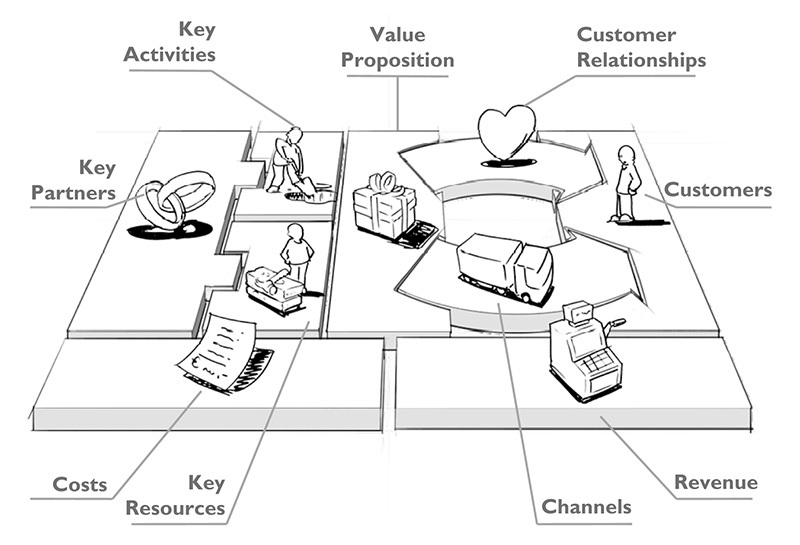Startup step by step: the first business model

We continue the series of articles on how to build a startup - we talk about each step with our own example. We have already described how to come up with an idea and how to assemble a team , now let's talk about a business model.
In a previous article, we mentioned lean startup, a common approach that we use. The brief point is that you do not need to do the product or service completely, but you need to do it step by step, checking the effectiveness of each step in a real audience.
Lean startup uses the business model canvas), as well as an alternative - lean canvas. This is a visual business flow chart showing key components and processes. Whatever version of canvas you choose, to create a model you need to answer a few key questions:
- What is the uniqueness of the product / service?
- What problems / needs does he solve?
- What resources are needed for implementation?
- Who will be the key partners?
- What are the channels for promotion and distribution?
- What will be the costs?
- How do you plan to earn?
- Where and when to take investments?
- Who is the target audience?
We will discuss the answers in our example. Recall that our project, Learzing, is an educational platform with educational applications / games and a social component.
Problem -> idea -> solution

The situation in the online education market is poor. In our opinion (and not only), online courses are often boring and ineffective. [1] This is a problem that we want to solve, we build on it to come up with an idea for our service.
We are confident that the future is in interactive learning. Add to this the gaming and social component, as well as humor, and get the next level of online education. People should enjoy learning, combine business with pleasure. This is a general idea , we build on it to come to a decision.
The platform, which contains educational applications and games on various topics, which makes it possible to learn with friends, entertains the user with game mechanics, allows you to engage the user more in the learning process, thereby increasing its effectiveness. [2] These are the components that together make our decision unique. The uniqueness here is not a big word, it is just the difference between a product and existing solutions.
Read more about how we came to our idea, as well as our discussions about online education in our first article .
Resources, Partners, and Channels

One of the key resources , and perhaps the most important, is the team. This is more than part of the business model, since a good team will not fall apart after failure, but will switch to another idea / model and continue on its way. Read more about the team in our second article .
Our key partners are teachers, educational institutions. Through teachers we can learn their own wishes and needs of students. Having learned the wishes and needs, we make an application prototype based on them. We test it together with teachers and students, make changes, test again, etc., as a result, we get the finished application. As well as potential customers. Thus, teachers are not only partners, but also channelsfor feedback, creating and promoting the product at the same time.
Since the platform involves a fairly large number of applications, and it is difficult to write a lot of good applications on our own, we need to seek partnerships with developers of educational applications and games - this is another category of partners.
To encourage users to learn, they can be awarded bonuses. For example, for passing the level, the student receives not only experience / achievements, but also something that is useful to him in real life - for example, exclusive discounts, gift certificates, coupons, etc. Hence, another category of partners is the company that will provide these bonuses.
Costs, revenues and investments

One of the pleasant things about a startup is that a team of enthusiasts works enthusiastically, believing in the success of the project. That is, there are no salaries, and all the expenses at the first stage are directly related to the creation and operation of the product: trips to hackathons (we note JetBrains EdTech Hackathon and HackDay ), collaboration tools (we use Redbooth and Google Docs), website hosting, private repository on GitHub, purchase of devices for testing (for example, iPhone 4 as the minimum technical requirement for a product), etc.
When studying the market, we found a successful and close-minded project with games for brain development - Lumosity. In order not to reinvent the wheel, we decided to focus on this project in many aspects, including the monetization model. Lumosity allows you to play for free the first 30 days, and then it becomes paid - you can pay every month or pay immediately for a year in advance. At the moment, we focus on this monetization model .
On third-party investments , we came to the conclusion that it is better to look for investors not at the stage when there is a business model or prototype, but at the stage when everything is already working and generating income. That is, in fact, when an investor is not really needed, or rather, it is needed so that a startup grows much faster than if you do it yourself.
At this stage, several models have already been tried, an effective one has been found, so it turns out that the funding received will go exactly where it is needed, and will not be wasted. This is beneficial for both startups and investors. If everything already works and is profitable, more options appear. You can negotiate with different investors, investments will be more, and the share of business that is given in exchange for investments will be less.
That is, at the start we try different models at our own expense ( bootstrapping ), and when everything has already worked out, you can attract investors to scale the business.
Another channel - crowdfunding - is unique in that it can be used simultaneously to get a response, promotion and financing of a product.
The target audience

The first comment we heard from our mentor when we talked about our idea is to decide on the target audience, now it’s too wide and blurry for you.
Well, we still have not decided. Children, adolescents, students, young people and people of middle and old age - among all these layers there are many inquisitive people who want to learn something new, learn something. Perhaps these will be companies interested in training their employees. Maybe our platform will be for several target audiences at once?
We decided that we will decide on CA in the process of developing the first applications and from the polls during development.
useful links
It will be useful to everyone who is not indifferent to "thrifty" startups:- Service for building lean canvas - Lean Stack .
- Step-by-step instructions for creating an online startup from lean startup guru Steve Blanca.
- Startup Handbook - Running Lean .
Theory and practice
Our first business model, of course, is approximate and theoretical. The question is whether the compiled model works and how effective it is. One can say for sure - very rarely something works exactly as planned. But you need to start somewhere, and step by step the model is checked and refined. Each of the points should be considered an assumption and verified in practice. We are sure that the model will change more than once, and perhaps it will become completely different.References
[1] Udacity's Sebastian Thrun, Godfather Of Free Online Education, Changes Course[2] Do Serious Games Work? Results from Three Studies
All articles in the series
- Startup step by step: the future of online education
- Startup step by step: team and mentors
- Startup step by step: the first business model
- How we did the educational platform: first design, landing page and logo
- How we did the educational platform: first application
- Making an HTML5 Quest: Using the MVC Pattern in Construct 2
- Making an HTML5 quest: creating a character and basic animation
